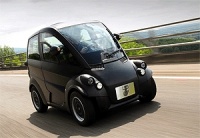Car-making process cuts capital investment
Formula One designer Gordon Murray has unveiled the first car to be built with a new manufacturing system he claims reduces capital investment by 80 per cent.

The three-seater T25 weighs 575kg and is responsible for around 40 per cent less emissions over its lifetime than an average car made today.
Murray’s iStream manufacturing process requires 20 per cent of the space of a conventional factory and could encourage more companies to build city cars such as the T25 or Smart models.
‘The reason people don’t make more A-segment cars is that you don’t make any profit on them,’ said Murray at the car’s launch this week at the Oxford University Smith School’s World Forum on Enterprise and Environment.
‘The actual capital investment on an A-segment and a C-segment [small family] car is virtually the same. This gives people a true opportunity to make money selling an A-segment car because the capital investment is tiny.’

iStream cars comprise a body of mechanically fastened panels made from recycled plastic bottles, around a lightweight composite chassis of thin-walled tubes. ‘The total tooling investment for the body is about six per cent of a stainless-steel car, so it’s massive change,’ said Murray.
Register now to continue reading
Thanks for visiting The Engineer. You’ve now reached your monthly limit of news stories. Register for free to unlock unlimited access to all of our news coverage, as well as premium content including opinion, in-depth features and special reports.
Benefits of registering
-
In-depth insights and coverage of key emerging trends
-
Unrestricted access to special reports throughout the year
-
Daily technology news delivered straight to your inbox









Water Sector Talent Exodus Could Cripple The Sector
Well let´s do a little experiment. My last (10.4.25) half-yearly water/waste water bill from Severn Trent was £98.29. How much does not-for-profit Dŵr...